Stop Motion Studio Founders are SAG/WGA Members, Yet Told Employees Not To Unionize
Documents Reveal Anti-Union Management at Stoopid Buddy Stoodios

Introduction
From knitting tiny sweaters to sculpting palm-sized props to time lapses of animators speeding around a moving puppet, studios and distributors have always been more than happy to showcase the creative and technical aspects of stop motion. These advertising campaigns often sell the medium as an oasis of tactile hand crafted art in today’s sea of digitally produced media. Despite the human element of stop motion being frequently celebrated by studios in the public eye, when it comes to discussions of day to day working conditions everyone becomes tight lipped…and for a good reason. To put it mildly, working conditions in stop motion are abysmal.
In addition to the usual eyestrain, back pain, and wrist injuries that plague 2D and CG (computer generated) animation workers, stop motion artists deal with a workplace filled with unique hazards found nowhere else in the “traditional“ animation industry. Building, decorating and lighting miniature sets in conjunction with puppet fabrication can lead to workers inhaling hazardous particles and handling flammable materials and dangerous chemicals, usually without proper PPE or safety procedures. In essence, stop motion is just a longer format live action production, for example a week of animating might equal a minute of footage.
Precarious working conditions, along with poor wages and scheduling, little to no employer accountability, widespread sexual harassment and a limited labor pool with limited projects to be hired on, has created a prefect storm of labor exploitation in stop motion. It’s always been kind of ironic that “lower risk“ animation jobs that entail working on computers (and sometimes paper) have a union (The Animation Guild, IATSE Local 839) , while stop motion workers who deal with hazardous chemicals, electrical wiring, industrial glues and paints, heat guns, sanding, airbrushing, plaster, molding/casting, silicon, resin, foam and more, do not.
The amount of fear in the stopmotion workforce regarding speaking up against work abuses cannot be overstated. For decades, stopmotion has been at the whim of larger studios and distributors in deciding if some or any projects will be green lit each year. With workers not knowing where and when work will come from within such a small community, getting blacklisted at even just one studio can be a death sentence for one’s career in the industry. From Screen Novelties to Starburns Industries, Laika to ShadowMachine, Bix Pix to Stoopid Buddy, every stop motion studio today has deeply entrenched labor problems that are long overdue for investigation by animation media outlets.
As of 2024, not a single stop motion studio in the American animation industry is or has even been unionized, nor has any come close. In the last 10 years, only two union campaigns received some media attention in the animation community, Bix Pix in 2015 and Stoopid Buddy Stoodios in 2016, both in Los Angeles. However both campaigns were quietly snuffed out before a majority of union cards could ever be signed, with management ending the organizing through a combination of disinformation and concessions.
2016 Stoopid Buddy Stoodios Union Campaign
Stoopid Buddy Stoodios is a stop motion studio located in Los Angeles, founded in 2011 by Seth Green, Matthew Senreich, Eric Towner, and John Harvatine IV. The studio is mostly known for the Adult Swim show Robot Chicken, which premiered in 2005, spanning 11 seasons so far.
In 2016, Cartoon Brew wrote of the unionization effort (emphasis mine):
“After a failed unionization attempt in 2015, the SB workers pushed harder in 2016, trying to join IATSE in some capacity (not part of The Animation Guild). [At the time] Stoopid Buddy, [was] the largest stop motion studio in southern California with about 200 employees…Some of the reasons workers gave for unionization included low pay which led to high turnover and younger inexperienced hires that were ok with the studios exploited practices… lack of wage scale transparency, healthcare, and poor scheduling…. Momentum for the unionizing effort has been spurred by the studio’s starting wages for artists, including assistant animators, compositors, and other visual effects staff that hover just above California’s $10 minimum wage.”
The documents included at the end of this article were shared with me by a 15+ yr veteran of the stop motion industry who asked to remain anonymous for fear of retaliation. The papers below consist of two sets of documents:
1) A 5 page pro-union document created by an anonymous worker, that aimed to answer basic questions of the unionizing process relating to stop motion while inviting workers to sign digital union cards on a designated IATSE webpage.
2) A 7 page anti-union response from management to the pro-union document above, as well as a 1 page anti-union letter signed by the studio’s founders.
Both sets were distributed internally (ie taped to walls, left on tables) during the 2016 unionization push. My hope is that by sharing these documents, animation workers (and theoretically any worker) can gain a better understanding of the language, phrases and arguments that have become standard in any anti-union push from management.
The “anti-union explainer” from Stoopid Buddy management is dense with MANY traditional anti-union phrases, claims and promises that have been used by employers since the dawn of time. Despite its length, I beleive papers are really worth reading carefully. I provided a Labor Notes bingo card that I encourage you to open in a new tab and see how fast you can get bingo as you read along. °˖✧◝(⁰▿⁰)◜✧˖°
Stoopid Founders Benefit from Unions But Not Workers
While union status for all four Stoopid Buddy founders remains unknown, we do know that at least half of them are actively benefiting from union membership. Seth Green is a SAG-AFTRA member and Matthew Senreich is part of the Writers Guild of America and SAG-AFTRA. Both men benefit from their unions by having access to grievance procedures, collective bargaining, healthcare, residuals, wage minimums and more.
Last year, during the 2023 WGA/SAG-AFTRA contract negotiations, Seth Green proudly supported the strikes. He was photographed at pickets in addition to posting and sharing pro-union statements on social media. Green’s tweet stating that “employees need to be protected and employers need to be fair” rings hollow and insincere when confronted with his approval to spread anti-union propaganda throughout his own stop motion studio.
More nuanced discussions about the financial costs/benefits of unionizing, healthcare eligibility based on hours worked, jurisdiction discussions, etc. fall to the wayside when the most obvious contradiction becomes, “If Stoopid Buddy founders do not believe in unions for their workers, why are they union members themselves?” It’s clear that Stoopid Buddy does not believe in any of the fancy anti-union explanations they sent to workers. They don’t want a union because they want to keep production costs low by exploiting their workers. They want to exploit, but not be exploited themselves. And if they were to argue to their animation workers “‘Well, unions are good for some but not for you, the unions make sense, sure, for certain industries, but not the one you’re in“, then they are using the same anti-union rhetoric as Walmart, Starbucks, even Andrew Carnegie, which isn’t the best look in my opinion.
It’s especially frustrating to see how Stoopid Buddy responded to workers trying to unionize with cries of poverty and threats of looming business instability, and a few years later go on to heavily invest in one of the most unstable and volatile areas of our current economy, the world of crypto. For years now Stoopid Buddy and its founders have been huge fan of cryptocurrencies, blockchains and NFTS which are notorious for their bubble economies and essentially being a money pit. Some of the projects Stoopid Buddy has produced in the crypto world include building an NFT parade float for the 2023 Rose Parade with an accompanying documentary, producing NFT animation festivals and producing NFT animated shorts, with a narrative voted on by NFT holders.
In a 2021 interview, Steve Aoki, a famous DJ and certified “crypto believer“ said:
So why can Stoopid Buddy take risks in the world of crypto but not unions? Why can cyrpto crash over and over again, and still Stoopid Buddy will return to throw more money in to that black void AND also claim that unions are too financial risky for the studio to even consider the thought of.
In 2022, Seth Green famously paid a ransom of 165 ETH, the equivalent of $260,000 at the time in order to be reunited with his Bored Ape Yacht Club NFT after it was “kidnapped” by hackers. He paid the ransom as he needed the copyright of the sad piece of “art“ in order to produce a tv show around the jpeg.
Talking to Stoopid Buddy workers who have worked there around 2016 and after, even after events such Covid 19, the WGA/SAG strikes, and the rise of crypto, the founders continue to have the same anti-union at their studio.
SB Anti-Union Document Fact Check
The basic goal with any anti-union campaign is not to generate a hatred of unions but simply to create doubt. Doubt can destroy even the most energetic union campaign from the inside out. Fear and pitting workers against each other can also aid in a campaign’s implosion. Workers can fight doubt through solidarity, inoculation (understanding how and why the employer will fight the organizing effort), and labor education. Below are examples of breaking down and fact checking some of the arguments Stoopid Buddy presented against unionizing in their documents (available in full at the end of the article).
“The Union is misleading you by suggesting that it can guarantee you whatever you want.
By Stoopid Buddy using phases like “The Union” (as opposed to “your union”), “inviting the Union in” or “the Union [with] their ghostwriters”, it immediately creates distance between the workers and their union. Implying that “The Union” is a third party entity coming in to nefariously pit workers against employers and ruin the business in the process, is an extremely old anti-union tactic.
If Stoopid Buddy were to unionize, the workers in the bargaining unit would elect their own negotiating committee from inside their own unit, usually with representatives from every department within the unit. These workers would also create their own contract proposals as well as elect their own officers if need be. “The union consists of co-workers with common interests acting to advance those interests. The union is obligated by law to fairly represent those interests. More important, the primary check and balance is that a democratic vote of the union’s members could result in a rejected contract or a defeated incumbent union official.”
As with anything where humans are involved, unions are not perfect and should not be romanticized. There is toxic behavior and abuses of power in unions, and workers should be critical and hold their unions accountable. There are a variety of different methods and actions workers can take to promote greater transparency and democracy within a union. Being critical of unions should not dissuade workers from organizing though, as to be left without a union can leave a workforce with little to voice or power in their day-to-day working conditions, which rarely leads to a positive outcome.
“Work for hire is a big part of our business; Stoopid Buddy needs to compete for work. This means it needs to competitively bid for work and perform jobs where Stoopid Buddy charges little over its production cost.”
“The Union is lying to you if they guarantee that top performers wages cannot go down. They could go down, increase, or remain the same. Remember that no other stop motion animation company is unionized, and to remain competitive with these other studios, Stoopid Buddy is likely unwilling to significantly raise the total amount it spends on wages.”
While it’s true that a union cannot guarantee anything until workers begin negotiating their first union contract, on average, a worker covered by a union contract earns 11.2% more in wages than a peer with similar education, occupation, and experience in a nonunionized workplace in the same industry. Those higher union wages can also lead to an increase in wages across the field regardless of union status, by standardizing wages in the industry.
Secondly, larger studios and producers (ex: Disney, Nickelodeon, Netflix, advertisers etc) do rely on a bidding system between stop motion studios in order to get the best deal on a project. However, this bidding system often leads to a race to the bottom, with winning studios often having paltry budgets and impossible deadlines while promising a high grade product. (This is also a problem in international outsourcing studios as well as the majority are non-union.) Without any safeguards, these ‘competitive bids’ ultimately lead to chaotic productions with workers often being pushed beyond their limit. Collective bargaining can be a way for workers to fight back against this industry practice by demanding minimums in areas such as wages, budgets, staffing and scheduling. Stoopid Buddy might give perks to help productivity in workers but ultimately, “money motivates employers, not the moral obligation … to treat employees “right.””
Instead of Stoopid Buddy seeing the unionization effort as an opportunity to break ground in the stopmotion industry and become a leader in improving the industry (not to mention the good PR it would bring imo), they reframe the unionization effort as a death sentence, implying that the workers themselves, by wanting livable wages, would be responsible for the business folding.
“Stoopid Buddy is not obligated to simply accept the [union contract] template's terms if it concludes in good faith that they are not in its best interest. The existing templates were created with the larger studios in mind who are bigger entities with deeper pockets. We are four individuals who put our money into a new venture that is just over 4-years old.”
Crying about being a small business (with no munies :^( ) is another popular excuse to prevent unionization. As stated previously, in 2016 Stoopid Buddy was the largest stop motion studio in Southern California with around 200 employees. Today, there are unionized VFX and animation studios that have bargaining units that range from 22, 76 to 300 workers. In the past few years, both editors (~24) and production workers (37) at ShadowMachine have unionized. Shadowmachine was originally founded as a stopmotion studio but has since expanded to CG and 2D divisions across multiple media platforms.
As the anonymous pro-union paper stated, “We don't want to punish the studio, we just want to negotiate for better healthcare and pension / welfare, among other things!” If a business closes, employees lose their jobs which is an outcome no worker ever wants. Very often when an employer cries “poor small business”, unions will respond saying “that’s totally fine, let’s look over your financials together and find a solution” which often leads to employers clamming up and moving on to another excuse.
“Stoopid Buddy's budget is not that different than your family budget. What a family can afford to spend is dependent on what you and other family members earn.”
“We view Stoopid Buddy as a family working together to produce great entertainment. In order for the family to function well, everyone needs to feel comfortable bringing any problems or issues they have to the attention of others in the family.”
A stop motion studio is not a “family”, “it is a business and all businesses should have unionized labor”. Employees might be pushed to embrace loyalty and go the extra mile using familial language, but its always one sided. Employers will punish or fire workers the second they think its beneficial to their bottom line. Seth Green’s estimated net worth is $40 million and doesn’t know how to animate, while stop motion workers at Stoopid Buddy have their hands covered in hot glue burns and can’t afford rent. Are these two types of people really on equal footing? A healthy family is NOT a “hyper patriarchal [one], where [a single] family member… unilaterally makes all the decisions in an authoritarian [way],” which is how your average American business operates.
As Adam Johnson explains in his podcast Citations Needed concerning anti-union rhetoric:
“It's been a HUGE source of pride to have a studio in our own backyard, beautiful Burbank, California. We would like to keep it that way.”
The threat of a business closing or moving due to unionizing is again another overused argument in anti-union rhetoric.
“According to a comprehensive study from 2003 that reviewed nearly 30,000 firms in a nearly two-decade span, there are two main types of places where unions come together: some organize at “highly-profitable enterprises” that are very likely to survive collectivization, while others organize at firms that are “poorly managed, or… faced recent difficulties,” making unionization particularly appealing to workers. The conclusion, however, was clear: “Unions likely do not affect businesses by making them more susceptible to failure or re-location, despite the fears of many employers and employees.”
Despite threatening to move the studio to curb unionizing, Stoopid Buddy still ended up opening a second office in Toronto, in 2021. When asked why they expanded, John “Harv” Harvatine stated “There’s an amazing talent pool up there — a lot of it from Sheridan College.” Seth Green added ”Not to sound obnoxious, but the U.S. has only recently realized that it’s possible to collaborate with artists from other countries. There’s an epic amount of talent out there.”
These responses are purposefully ignorant and half-baked. For decades, Canada (along with Australia, South Korea, Taiwan) has been the bedrock for US animation outsourcing. Cheaper labor and a lack of unions internationally had led to studios moving most of US animation production outside the country. Stoopid Buddy was not doing anything relatively new with this endeavor. The year Stoopid Buddy opened their Toronto office, 2021, was the same year that Oasis Animation (Montreal) made history becoming the first ever unionized animation studio in Canada.
In the end, their attempt to expand to Toronto seemed ill fated. When talking to my sources, many were unsure whether the Toronto studio was still functional in any meaningful capacity. As of writing this article, the only evidence of this studio’s existence is an email address. Ultimately, the threat of outsourcing should not be seen as a valid excuse to avoid unionization. Outsourcing is already an entrenched reality in animation and in stop motion it could be moving work outside of the US or even shutting down studio sound stages to cut cost while forcing stop motion workers to animate remotely at home, putting costs of production and workspaces onto the shoulders of the individual workers.
“We sent this [document] to your home so you might share it with members of your family.”
“Unions typically rigidly apply seniority. Seniority does not reward creativity and hard work. That is particularly difficult for junior employees.”
Both these sentiments are geared to generate infighting, among workers and at home. Union organizers often stress to workers that its crucially to connect with coworkers and family BEFORE the employer can come in and start planting seeds of doubt. If the employer can spread fear and confusion among the families of workers, the support network of union drive can collapse, leaving workers feeling isolated.
Secondly, though hierarchies can exist in union benefits, they don’t have to. The first stop motion workers to unionize would have the freedom to decide what they think works best for their industry, or the very least at their studio. In addition, senior levels of staff usually demand higher wages, which Stoopid Buddy has been able to avoid all this time by having high turnover rates with young naive workers that are so enamored with chance to work at the studio they don’t mind (or realize) the exploitation occuring to them and their cohort.
“Shortly thereafter we implemented a paid vacation and holiday program, which was not even requested. We created our health insurance program, increased the wage rates for certain employees, and hired Maria to handle human resources for us.
While it may not have been all you had wished for, it represented a big improvement, and ALL YOU HAD TO DO WAS TO ASK and you even got more than requested. No Union was needed. It cost you nothing: you did not have to pay any dues and you did not have to agree to subordinate your own needs to that of the Union ---including going out on strike if the Union calls for one.
…inviting the Union in comes with definite economic costs and other potential costs that may nullify or exceed any increases the Union can secure at the table. Why would you want this?“
Here you can see the studio take a defensive stance in providing concessions to its workers. Stoopid Buddy condescendingly questions their workers’ intelligence while not recognizing that ‘wanting to unionize’ is a very clear form of worker communication. Though these concessions can be good in the short term, there is nothing stopping the business from limiting who benefits from these concessions and their longevity. However, their earlier claims of not being able to afford workers benefits comes into question when all of a sudden they can hire an HR person and increase some wages without the studio bursting into flames.
Lastly, regarding strikes, striking is the LAST resort in any labor negotiation and cannot happen without the full support of union members. It requires multiple steps like strike authorization votes, arbitration attempts and more. Striking is not easy and can be extremely draining on workers and their families. There are a variety of different escalation tatics that workers can use to exert pressure on employers without needing to strike. However, what Stoopid Buddy fails to mention in their fear mongering about strikes is that when a union feels compelled to strike it means that that there has been a severe communication breakdown, and the employers are not negotiating in good faith. The employer has either been enagaging in union busting and underhanded tactics, violating labor policy or has refused any and all requests from the union to come to the table and discuss issues with workers.
Here is a small sample from National Labor Relations Act, of some the different things an employer can do that could be seen as a labor violation and subject to an “unfair labor practice’ charge. Most of these are either stated or implied in the Stoopid Buddy anti-union documents.
Conclusion: Why share documents about an almost 10 year old failed union campaign now?
On a practical level, I could only write about this now since I only learned about these papers in these last few weeks. While I cannot control why there wasn’t more publicity on the subject matter back in 2016, what I can do is publish these papers now that I’m in a position to do so. Despite being old, these papers still have value because accessible in depth essays, articles, or anything really around the subject of stop motion and labor are a rarity. I believe this lack of conversation and publicity has helped in making organizing more difficult, and contributes to why there isn’t a current unionizing effort in stop motion. People can’t act if they don’t have confidence, and people can’t have confidence if they don’t have information. Despite being from almost ten years ago, the anti-union arguments that Stopped Buddy presented are almost verbatim to the points brought up in modern day conversations about unionizing in stop motion.
The stop motion workers I talked to while writing this (I admit too chunky) article expressed feelings of despondency throughout our conversations. “No one cares about stop motion.” “Nobody gives a shit about us.” “People only care about stop motion when they need a Christmas special.” Fear of employer retaliation combined with feeling a lack of outside support, has led to stop motion workers freezing in place, unable to do anything other than to keep working with their heads down in frustration. In addition to Stoopid Buddy and Bix Pix, there have also been multiple union attempts at Portland-based Laika, with one in particular gaining the most traction in 2018/19 but again due various factors, including a lack of media coverage it was quickly and quietly crushed by management.
I’m a freelance animator and animation labor researcher, with some experience in labor organizing outside of animation. I don’t have any professional experience in stop motion. I can’t tell stop motion workers how or when to unionize. But as a fellow animation worker, what I can help with is spreading knowledge. Sometimes just having information that is easy to read and share can be the first step in laying the groundwork for something bigger in the future.
Unionizing stop motion is not easy. There are decades of chronic issues to be addressed and sifted through. There are important conversations to be had about union jurisdiction, healthcare eligibility based on hours worked, union protection across different states, and more. However these genuine conversations cannot be had when there is a plethora of misinformed rumors, hearsay and disinformation polluting stop motion workers’ understanding of what it means to unionize.
Some might say these documents are outdated as they might not show the studios’ current stance on the subject matter, but since Stoopid Buddy is still not unionized while its founders continue to benefit from unions on their own, the situation has not changed in any meaningful way. According to the stop motion workers I talked to, the studio is still actively hostile to workers wanting to express their right to collective bargaining, further cementing the studio as Stoopid indeed.
Here are some quotes from current and former workers who spoke on condition of anonymity):
“[A few years ago] the Buds got called out for having a group chat with a bunch of men on crew where they openly talked about female crew member’s appearance.”
“My friend once got her hand sliced on some old machinery at [Stoopid Buddy], her supervisor put super glue on the wound and said get back to work.”
“[Stupid Buddy] were one of the most abusive places I’ve worked at. And they have no HR department to make things worse (they say they do, but they actually don’t)”
“[Stoopid Buddy] used down payments from future productions to pay off current/previous productions. So we had to put down different pay codes everytime in our time sheet. They had shows that were weeks behind schedule and millions of dollars over budget.”
“[Stoopid Buddy] refuses to fire the same horrible predatory men because of their buddy system. They are loyal to men who’ve been there the longest, even if they are horrible monsters.”
“There was a normalized drinking culture at Stoopid Buddy. If you walked in there right now I can tell you where all the liquor is hidden.”
“They told us that if we unionized they would move production to Canada.”










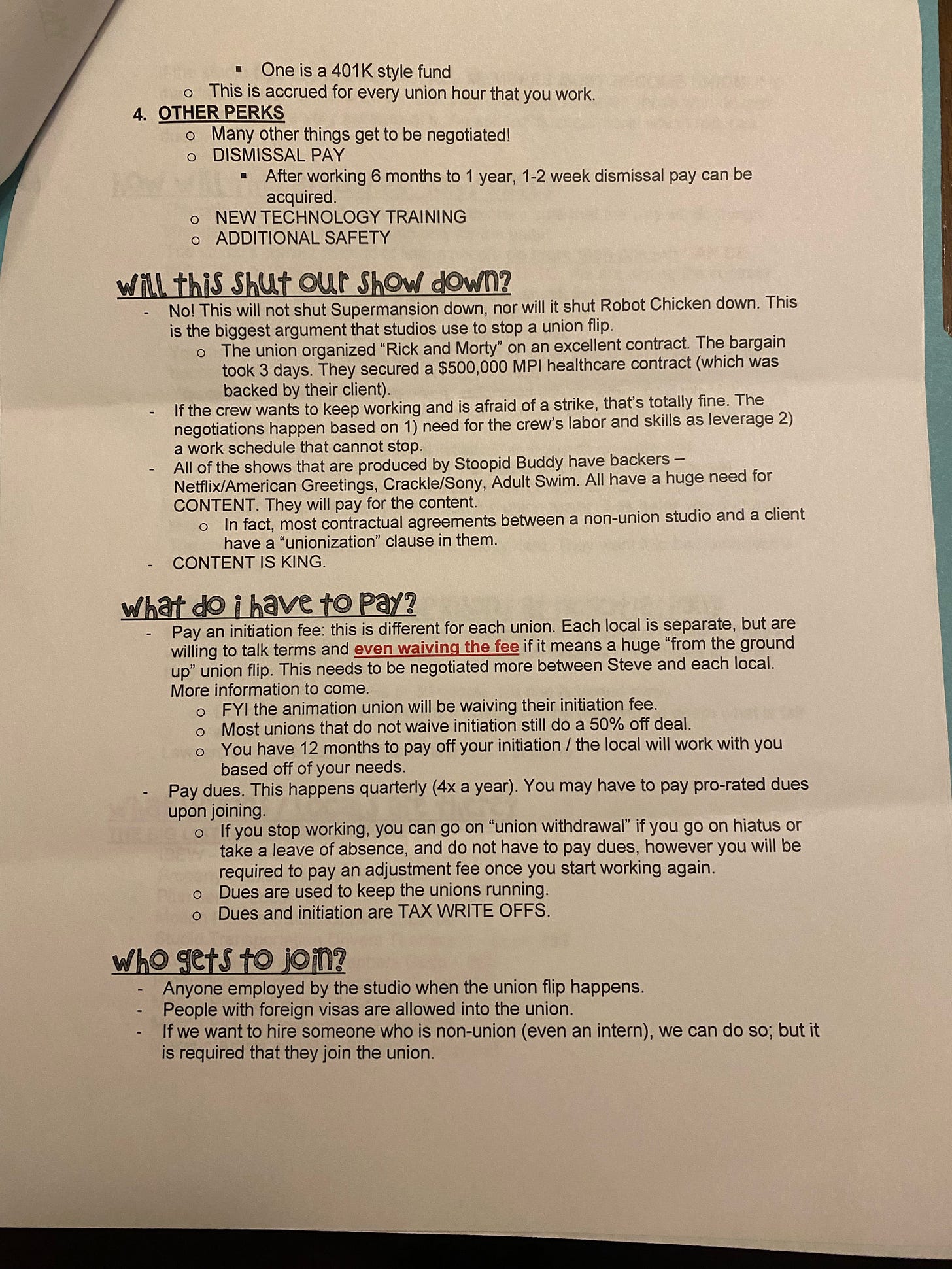
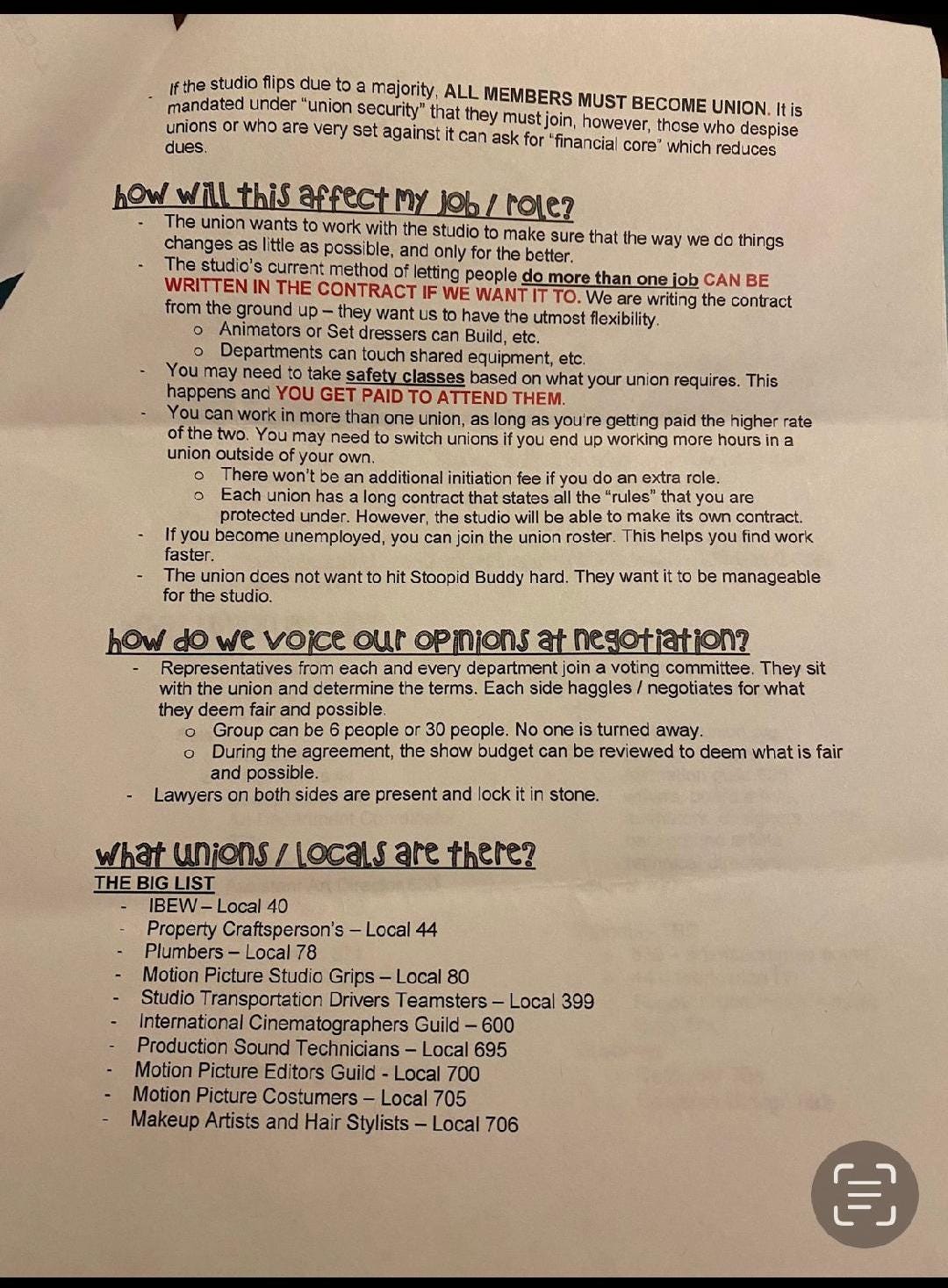

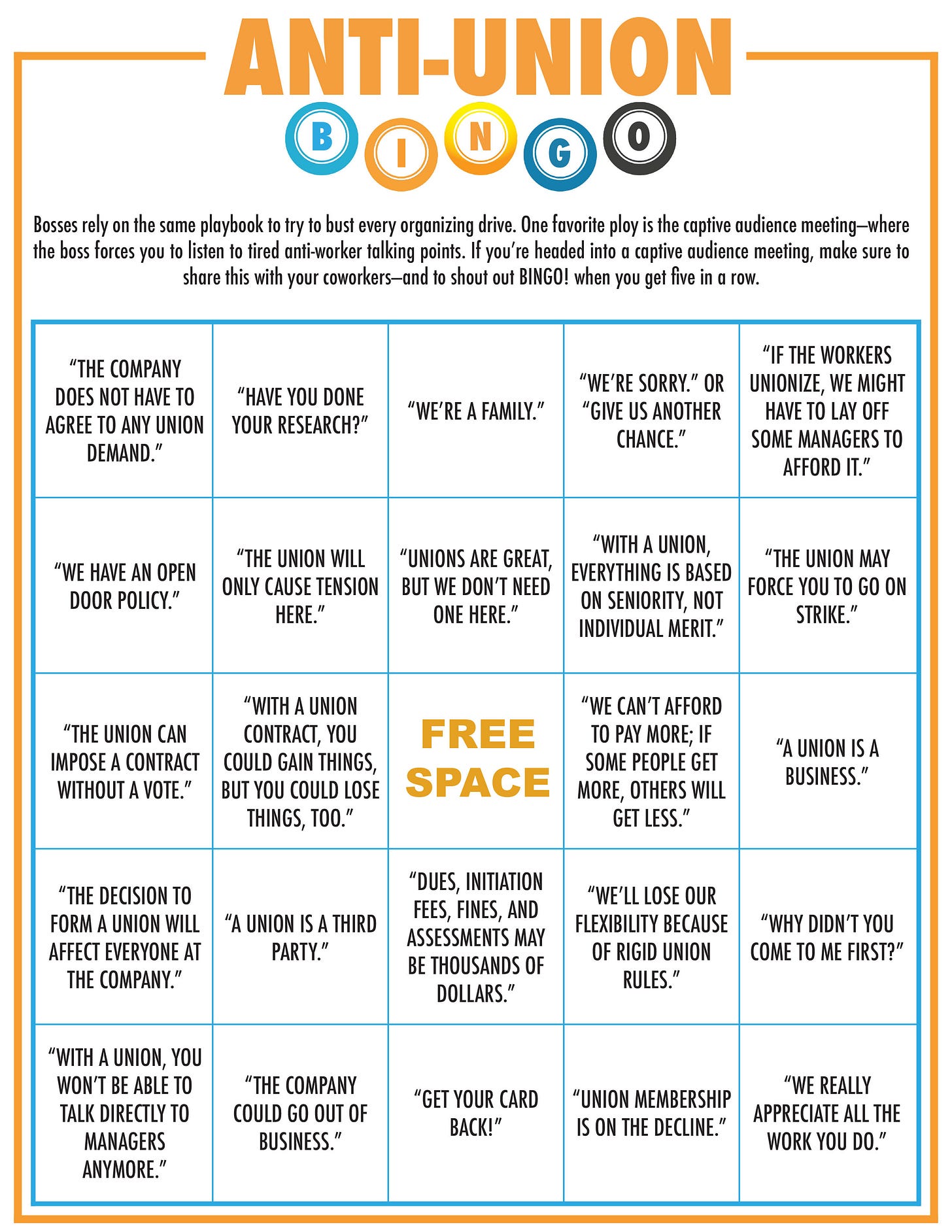
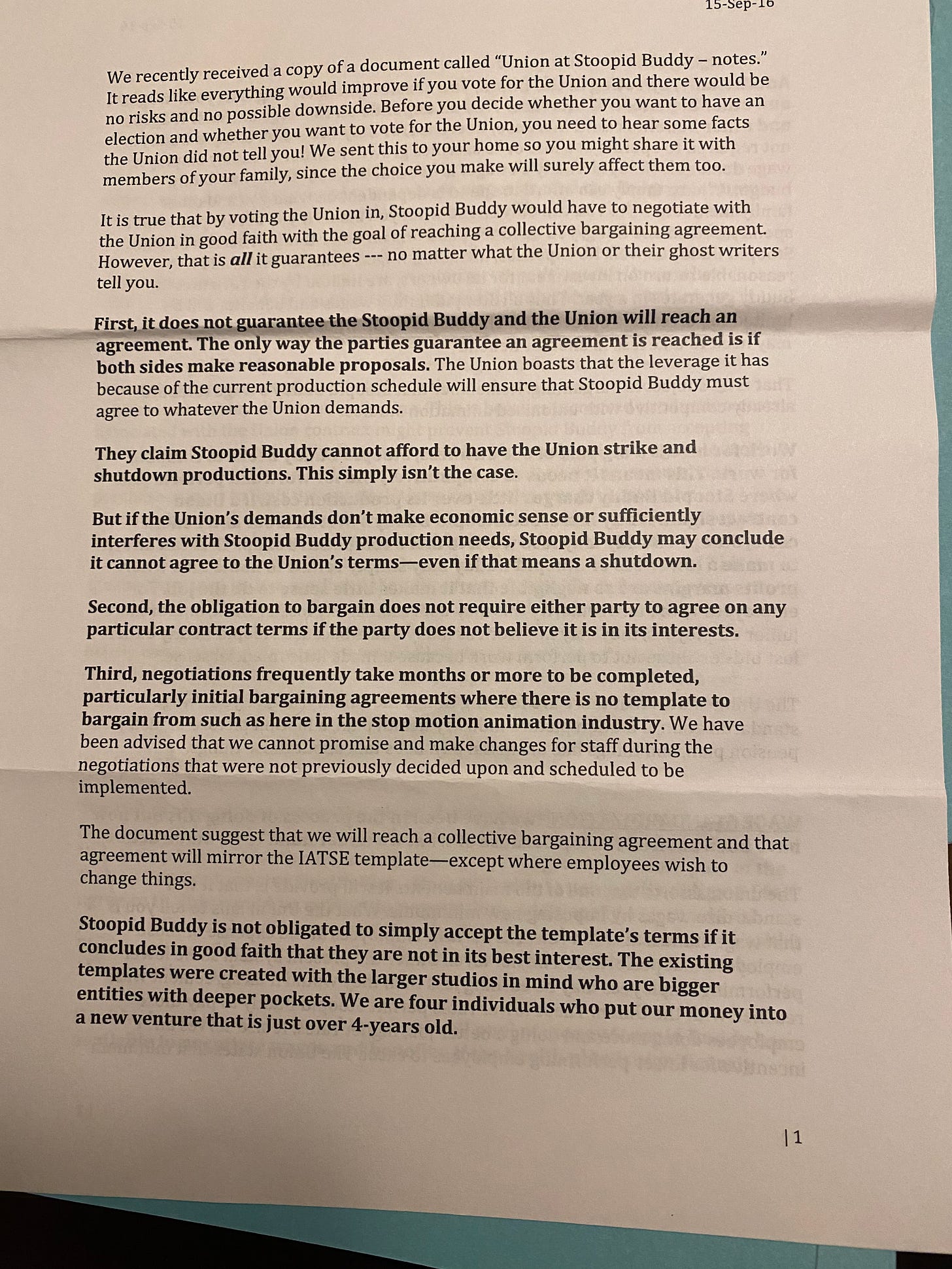
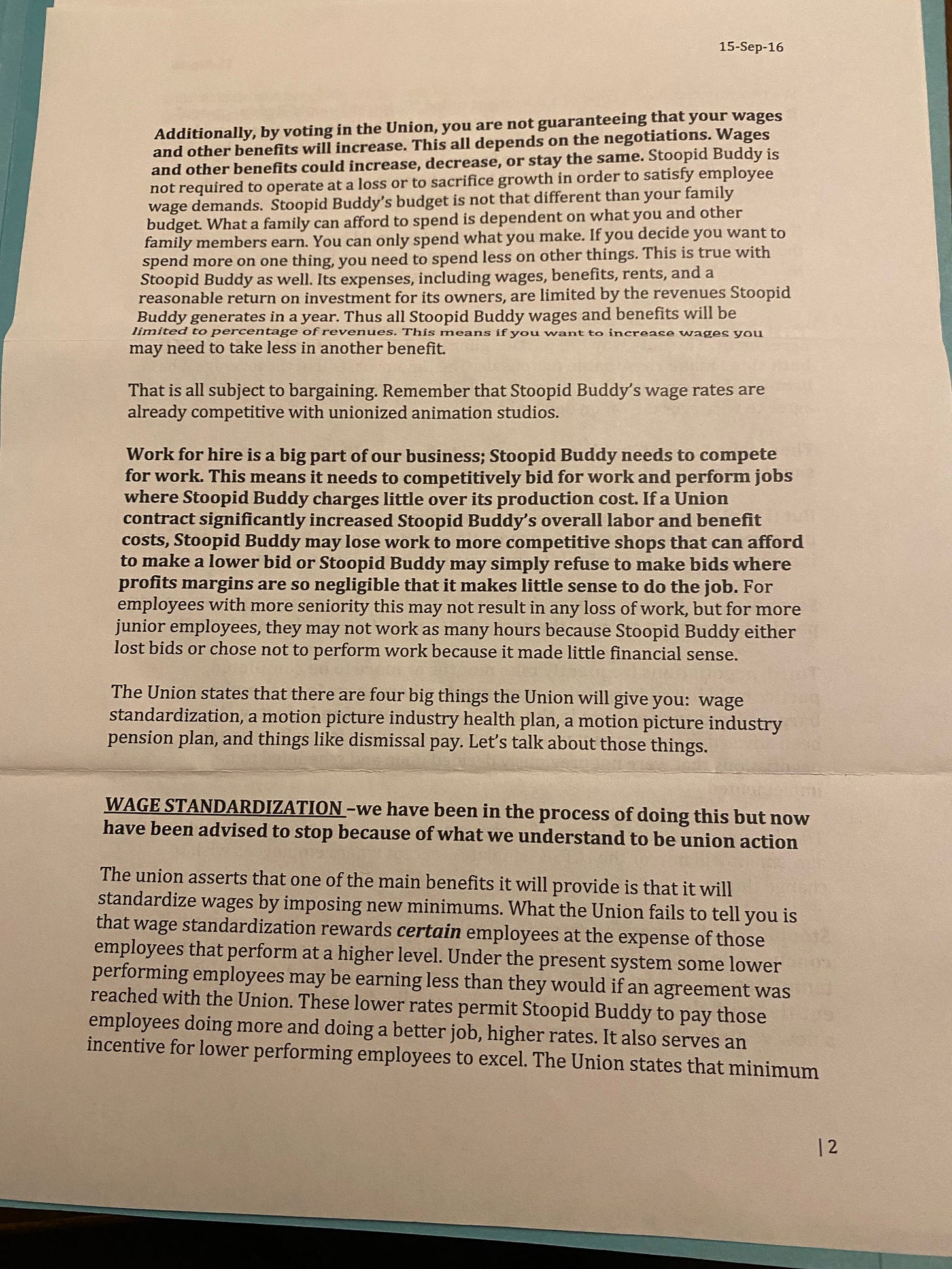
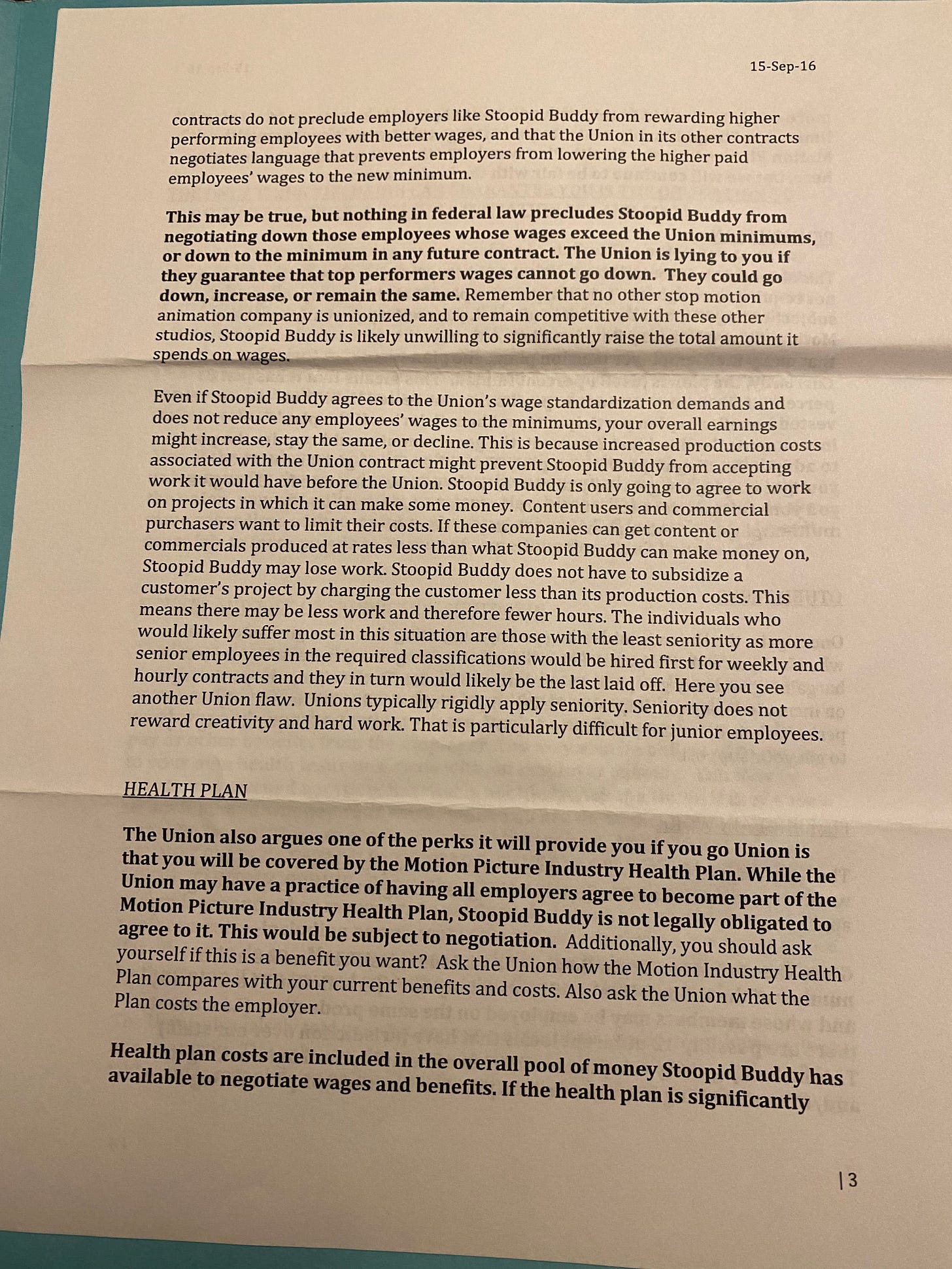

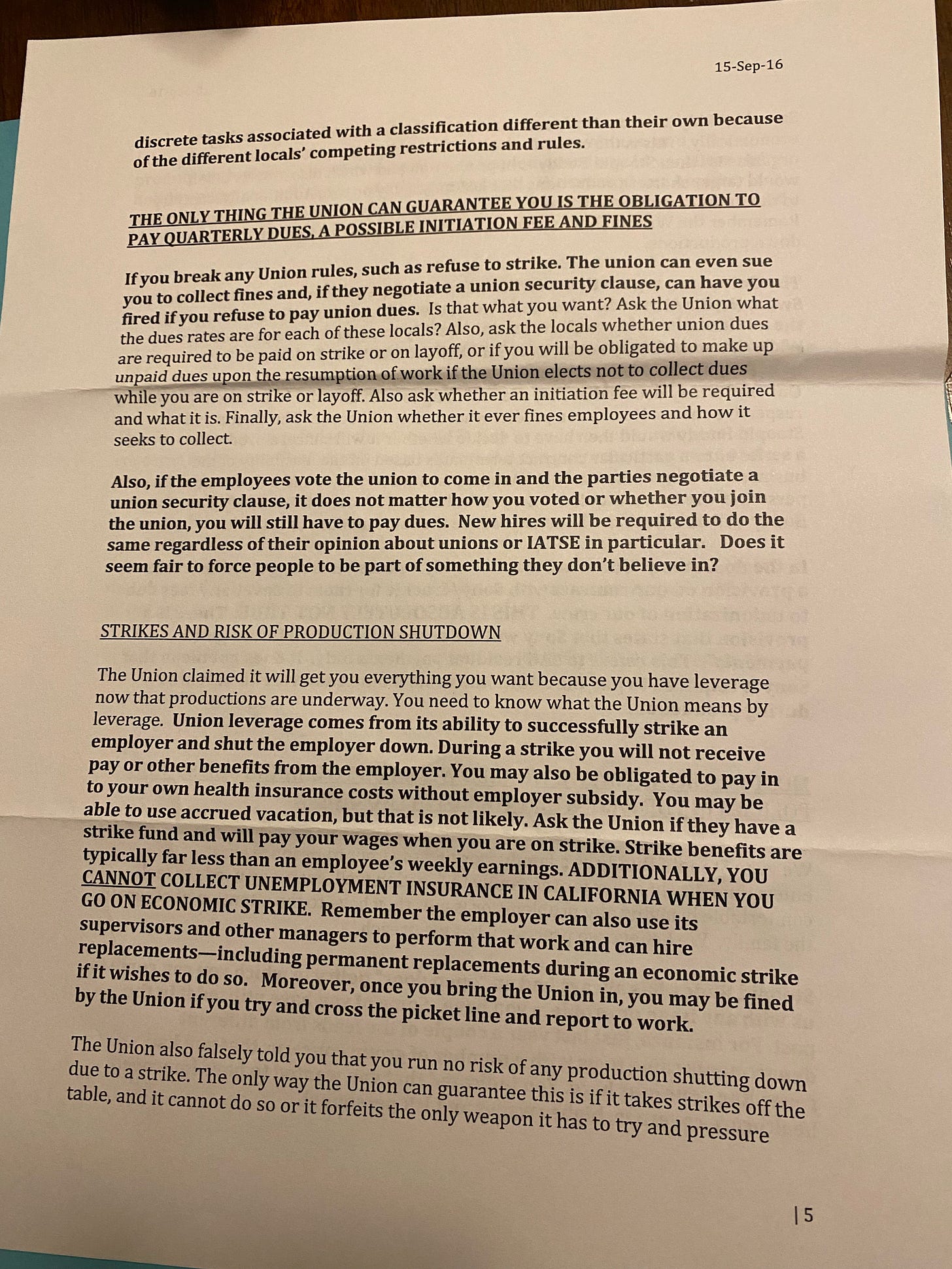
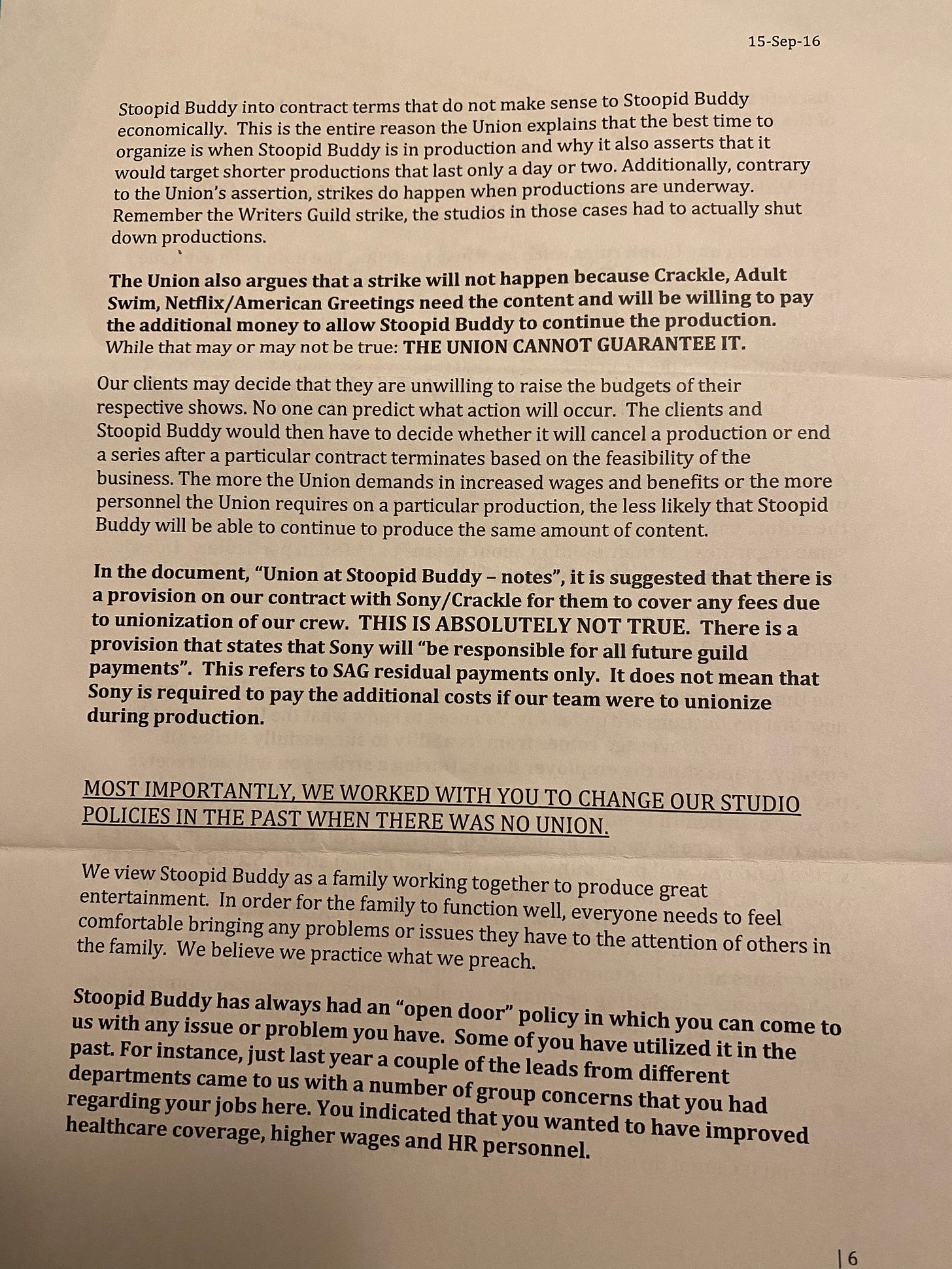
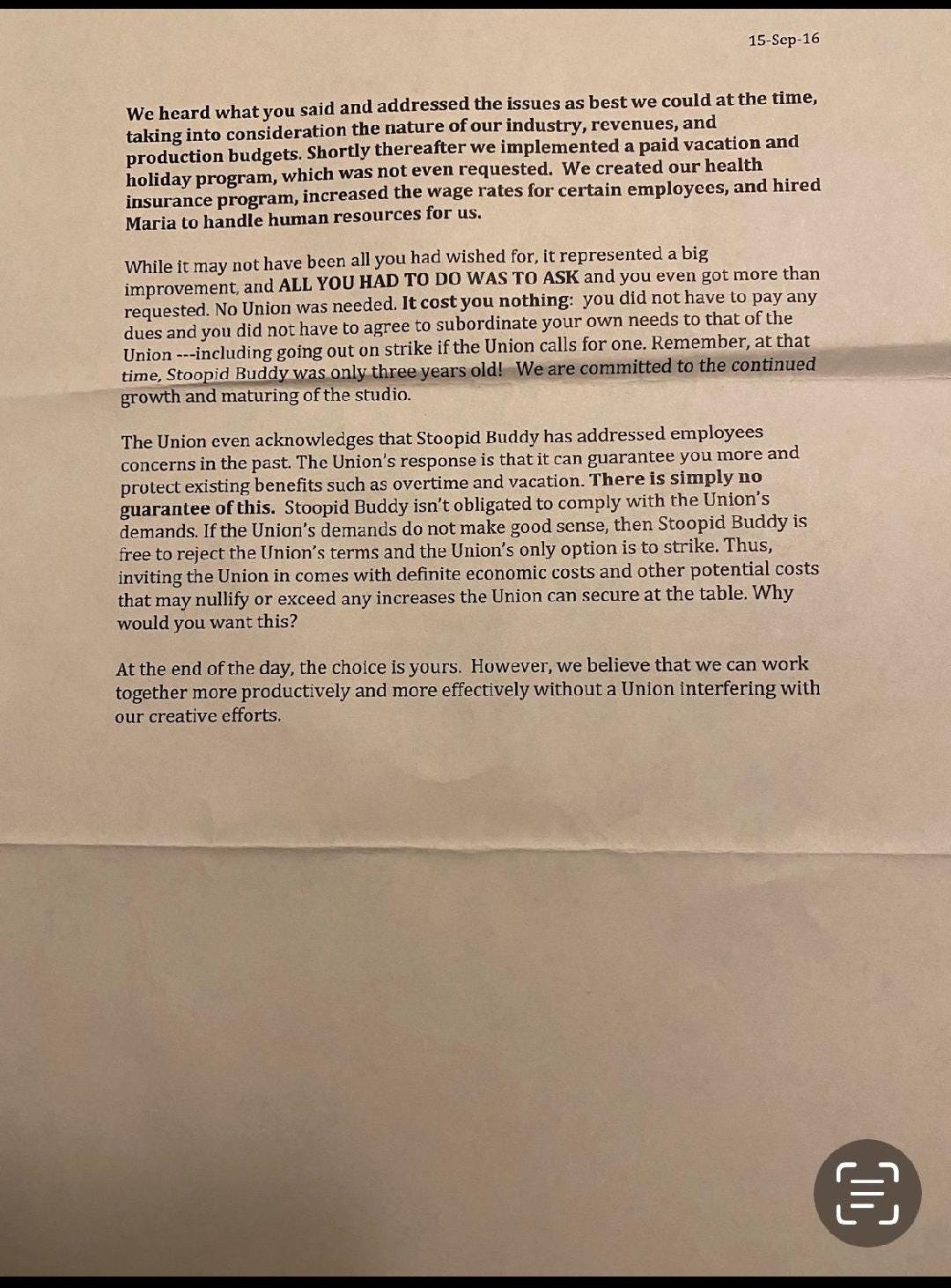
I really appreciate all the work you're doing, keep on fighting the good fight and educating